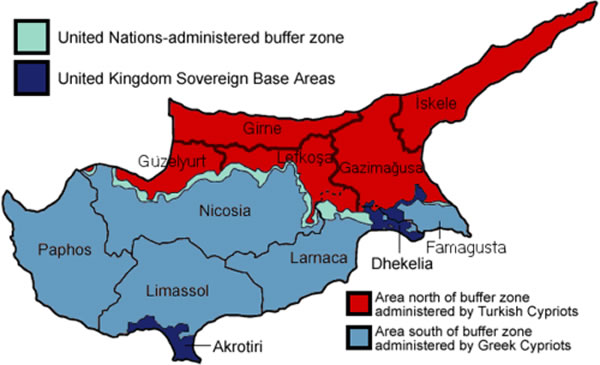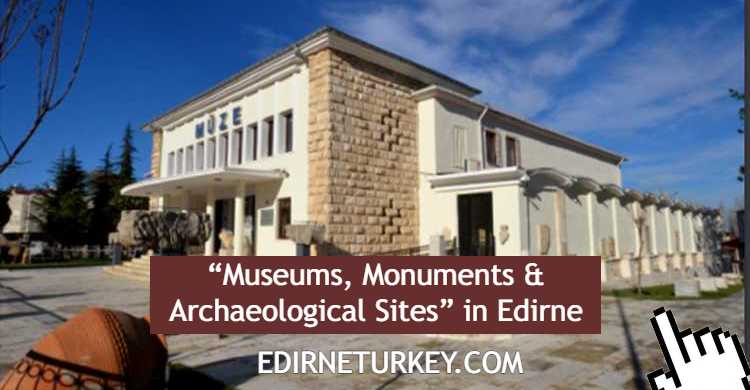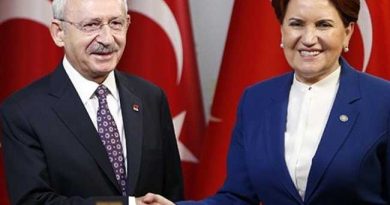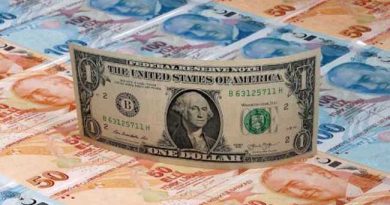Cyprus issue and the conflict between Turkey and Greece from past to present

Cyprus issue has been a main conflict between Turkey and Greece for many years. Naturally, opponents have and share different views on the issue and both sides accuse the other party of not abiding by international law and so forth. However, if we wish to have a quick look at what happened in the past and the position of both parties below text could help to be informed to a substantial extent.
CYPRUS ISSUE; WHAT HAPPENED AND WHO IS TO BLAME?
Cyprus which once belonged to the Ottoman Empire was given to Great Britain with the Lausanne treaty in 1923. There were two different communities on the island of which 70 percent were Greeks. After a period gone by under British rule unrest started to be observed in Cyprus, mainly originating from Greek Cypriots seeking whole control on the island.
To cut a long story short Greek Cypriots targeting to annex the island to Greece (based on a plan called ENOSIS) with the help of Greek Administration took chances several times to achieve their goals. Eventually, following the return of General Grivas to Cyprus to form EOKA-B, which was again committed to making Cyprus a wholly Greek island and annexing it to Greece undesired tragic events started progressing at a very fast pace. Grivas said. “The Greek forces from Greece have come to Cyprus in order to impose the will of the Greeks of Cyprus upon the Turks. We want ENOSIS but the Turks are against it. We shall impose our will. We are strong and we shall do so.”
Just to remind at this point, the civilian massacres of 1963, 1964, 1967 and 1974 were also of extreme importance to understand the Turkish Cypriot negotiating position to this day.
Greek Invasion and coup on the island
By 15th July 1974 a powerful force of mainland Greek troops assembled in Cyprus and with their backing the Greek Cypriot National Guard, in a coup d’etat, overthrew Makarios and installed Nicos Sampson as “President.” On 22nd July Washington Star News reported: “Bodies littered the streets and there were mass burials… People told by Makarios to lay down their guns, were shot by the National Guard.”
Turkish Cypriots appealed to the Guarantor powers for help, but only Turkey was willing to give any effective response. The Greek newspaper Eleftherotipia published an interview with Nicos Sampson on 26th February 1981 in which he said “Had Turkey not intervened I would not only have proclaimed ENOSIS – I would have annihilated the Turks in Cyprus.”
In his book “The Way the Wind Blows”, former British Prime Minister, Sir Alec Douglas-Home said: “I was convinced that if Archbishop Makarios could not bring himself to treat the Turkish Cypriots as human beings, he was inviting the invasion and partition of the island.”
US Under-Secretary of State, George Ball, said “Makarios central interest was to block off Turkish intervention so that he and his Greek Cypriots could go on happily massacring Turkish Cypriots”
Turkey’s intervention
After consultations with Britain which did not want to take joint action under the Treaty of Guarantee, Turkey intervened as a Guarantor Power on 20 July 1974 in conformity with its rights and obligations deriving from the Treaty of Guarantee. The operation was named “CYPRUS PEACE OPERATON” by Turkey as it only aimed to bring peace to the island, at the time. Intervention by Turkey blocked the way to annexation of the Island to Greece and brought security and hope to the Turkish Cypriots, after eleven years.
In an article on 28th February 1976 in the Greek Cypriot press Father Papatsestos said: “It is a rather hard thing to say, but it is true that the Turkish intervention saved us from a merciless internecine war. The Sampson regime had prepared a list of all Makarios supporters, and they would have slaughtered them all.” Many of the people saved by Turkey are members of the present Greek Cypriot leadership.
In July 1974, after the first phase of the Turkish intervention, an international conference was held at Geneva between Turkey, Greece and Britain. It was agreed that Greek and Greek Cypriot forces would leave all the Turkish Cypriot enclaves, but showing disregard for international agreements they proceeded instead to murder almost the entire civilian population of six Turkish Cypriot enclaves in both the north and south of the island, and despite the presence of UN troops in Cyprus .
Consequently, Turkey “had to” launch the second phase of the operation on August 14, securing control of Mesaoria, Famagusta, Karpasia and Morphou as no positive or constructive response was received from the Greek Cypriot side despite talks in LOndon and Geneva and agreement reached between parties.
WHAT DID THE INTERNATIONAL PRESS WROTE ABOUT IT AT THE TIME?
The German newspaper Die Zeit wrote on 30th August 1974 “the massacre of Turkish Cypriots in Paphos and Famagusta is the proof of how justified the Turkish were to undertake their (August) intervention”. In the village of Tokhni on 14th August 1974 all the Turkish Cypriot men between the ages of 13 and 74, except for eighteen who managed to escape, were taken away and shot. (Times, Guardian, 21st August)
In Zyyi on the same day all the Turkish Cypriot men aged between 19 and 38 were taken away by Greek Cypriots and were never seen again. On the same day Greek Cypriots opened fire in the Turkish Cypriot neighbourhood of Paphos killing men, women, and children indiscriminately. On 23rd July 1974 the Washington Post reported “In a Greek raid on a small Turkish village near Limassol 36 people out of a population of 200 were killed. The Greeks said that they had been given orders to kill the inhabitants of the Turkish villages before the Turkish forces arrived.” (See also Times, Guardian, 23rd July).
“The Greeks began to shell the Turkish quarter on Saturday, refugees said. Kazan Derviş, a Turkish Cypriot girl aged 15, said she had been staying with her uncle. The (Greek Cypriot) National Guard came into the Turkish sector and shooting began. She saw her uncle and other relatives taken away as prisoners, and later heard her uncle had been shot.” (Times 23.7.74)
“Before my uncle was taken away by the soldiers, he shouted to me to run away. I ran to the streets, and the soldiers were shooting all the time. I went into a house and I saw a woman being attacked by soldiers. They were raping her. Then they shot her in front of my eyes. I ran away again and Turkish Cypriot men and women looked after me. They were escaping as well. They broke holes in the sides of houses, so we could get away without going into the streets. There were lots of women and children screaming, and soldiers were firing at us all the time.”
On 28th July the New York Times reported that 14 Turkish-Cypriot men had been shot in Alaminos. On 24th July 1974 “France Soir” reported “The Greeks burned Turkish mosques and set fire to Turkish homes in the villages around Famagusta. Defenceless Turkish villagers who have no weapons live in an atmosphere of terror and they evacuate their homes and go and live in tere a shame to humanity.”
On 22nd July Turkish Prime Minister Ecevit called upon the UN to “stop the genocide of Turkish-Cypriots” and declared “Turkey has accepted a cease-fire, but will not allow Turkish-Cypriots to be massacred” (Times 23rd July). At the beginning of the Second Geneva Conference he said “A solution which is not based on geographical separation will not work. It is out of the question for us to entrust the safety of the Turkish Cypriots to the Greeks, who cannot even rule themselves. The areas around the Turkish forces are being mined, and the Turkish Cypriot villages are still under siege.”
The UK House of Commons Select Committee on Cyprus reported in 1976 that “the second phase of military operations was inevitable in the view of your committee as the position reached by Turkish forces at the time of the first ceasefire was untenable militarily”
On 12th March 1977 Makarios declared “It is in the name of ENOSIS that Cyprus has been destroyed.”
The Cyprus question has been the subject of negotiations, under U.N. auspices, between the Turkish Cypriot and Greek Cypriot peoples, as the two parties to the Cyprus dispute, since 1968. The details of inter-communal talks held between 1968-1974, 1975-1979, 1980-1983, 1988-1992 and 1999-2004 are recorded in the annals of the U.N. Security Council and the U.N. General Assembly.
The fundamental basis of the search for a just and lasting solution in Cyprus has been the equal partnership of the two peoples in the Island (the internal balance) and the maintenance of the balance established between the two motherlands, Turkey and Greece (the external balance) over Cyprus.
In the course of the efforts conducted under the auspices of successive UN Secretaries-General for a settlement, a number of basic parameters have emerged, such as bi-zonality, political equality, continuation of the Treaties of Guarantee and of Alliance, resolution of the property issue on the basis of global exchange and/or compensation and restrictions on the three freedoms (of movement, settlement and property).
PLEASE GO TO LINK FOR DETAILED INFO
http://www.mfa.gov.tr/cyprus-_historical-overview_.en.mfa





